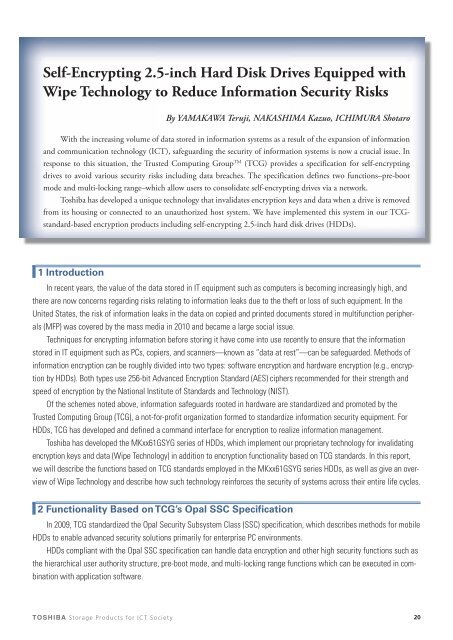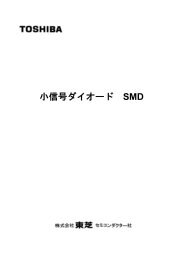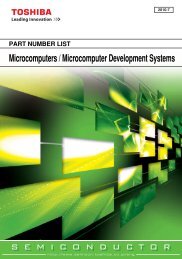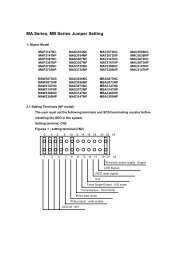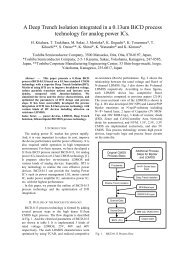Self-Encrypting 2.5-inch Hard Disk Drives Equipped with Wipe ...
Self-Encrypting 2.5-inch Hard Disk Drives Equipped with Wipe ...
Self-Encrypting 2.5-inch Hard Disk Drives Equipped with Wipe ...
You also want an ePaper? Increase the reach of your titles
YUMPU automatically turns print PDFs into web optimized ePapers that Google loves.
<strong>Self</strong>-<strong>Encrypting</strong> <strong>2.5</strong>-<strong>inch</strong> <strong>Hard</strong> <strong>Disk</strong> <strong>Drives</strong> <strong>Equipped</strong> <strong>with</strong><br />
<strong>Wipe</strong> Technology to Reduce Information Security Risks<br />
By YAMAKAWA Teruji, NAKASHIMA Kazuo, ICHIMURA Shotaro<br />
With the increasing volume of data stored in information systems as a result of the expansion of information<br />
and communication technology (ICT), safeguarding the security of information systems is now a crucial issue. In<br />
response to this situation, the Trusted Computing Group TM (TCG) provides a specification for self-encrypting<br />
drives to avoid various security risks including data breaches. The specification defines two functions–pre-boot<br />
mode and multi-locking range–which allow users to consolidate self-encrypting drives via a network.<br />
Toshiba has developed a unique technology that invalidates encryption keys and data when a drive is removed<br />
from its housing or connected to an unauthorized host system. We have implemented this system in our TCGstandard-based<br />
encryption products including self-encrypting <strong>2.5</strong>-<strong>inch</strong> hard disk drives (HDDs).<br />
1 Introduction<br />
In recent years, the value of the data stored in IT equipment such as computers is becoming increasingly high, and<br />
there are now concerns regarding risks relating to information leaks due to the theft or loss of such equipment. In the<br />
United States, the risk of information leaks in the data on copied and printed documents stored in multifunction peripherals<br />
(MFP) was covered by the mass media in 2010 and became a large social issue.<br />
Techniques for encrypting information before storing it have come into use recently to ensure that the information<br />
stored in IT equipment such as PCs, copiers, and scanners—known as “data at rest”—can be safeguarded. Methods of<br />
information encryption can be roughly divided into two types: software encryption and hardware encryption (e.g., encryption<br />
by HDDs). Both types use 256-bit Advanced Encryption Standard (AES) ciphers recommended for their strength and<br />
speed of encryption by the National Institute of Standards and Technology (NIST).<br />
Of the schemes noted above, information safeguards rooted in hardware are standardized and promoted by the<br />
Trusted Computing Group (TCG), a not-for-profit organization formed to standardize information security equipment. For<br />
HDDs, TCG has developed and defined a command interface for encryption to realize information management.<br />
Toshiba has developed the MKxx61GSYG series of HDDs, which implement our proprietary technology for invalidating<br />
encryption keys and data (<strong>Wipe</strong> Technology) in addition to encryption functionality based on TCG standards. In this report,<br />
we will describe the functions based on TCG standards employed in the MKxx61GSYG series HDDs, as well as give an overview<br />
of <strong>Wipe</strong> Technology and describe how such technology reinforces the security of systems across their entire life cycles.<br />
2 Functionality Based on TCG’s Opal SSC Specification<br />
In 2009, TCG standardized the Opal Security Subsystem Class (SSC) specification, which describes methods for mobile<br />
HDDs to enable advanced security solutions primarily for enterprise PC environments.<br />
HDDs compliant <strong>with</strong> the Opal SSC specification can handle data encryption and other high security functions such as<br />
the hierarchical user authority structure, pre-boot mode, and multi-locking range functions which can be executed in combination<br />
<strong>with</strong> application software.<br />
TOSHIBA Storage Products for ICT Society 20
SPECIAL REPORTS<br />
In the hierarchical user authority structure function, access is controlled <strong>with</strong> two types of authority, Administrator and<br />
User, which allows passwords for the HDD to be controlled by the application software, whereas in conventional password<br />
control only the Basic Input/Output System (BIOS) (Note 1) was used. Thanks to this function, centralized control is made<br />
possible through the Administrator authority.<br />
Pre-boot mode is a mechanism that allows a dedicated pre-boot space to be initialized when the PC is booted prior to<br />
the system software (OS). A PC using this function executes<br />
user authentication upon boot if data, including user authentication<br />
screen data, is preset in the pre-boot space, preventing<br />
The pre-boot space is Pre-boot space<br />
the OS from being loaded unless the user successfully<br />
including OS startup<br />
visible, but normal data,<br />
data, is not.<br />
The state changes<br />
authenticates. This creates a high security environment in<br />
only after<br />
<strong>Disk</strong> space<br />
successful user<br />
<strong>Disk</strong> space<br />
which, for example, the OS of the PC can be loaded only after<br />
(a) Pre-boot mode<br />
(b) Normal mode<br />
the user has authenticated through advanced means such as<br />
biometric identity verification or IC cards (Figure 1).<br />
The multi-locking range function is a mechanism for<br />
Figure 1. Pre-boot mode — The content of the entire disk is visible in normal mode.<br />
In pre-boot mode, only the pre-boot space is shown until authentication is<br />
completed, thus concealing the OS.<br />
using several secure spaces (Note 2) split from an HDD’s disk<br />
space. Each split space is protected <strong>with</strong> a different cipher<br />
key so that individual users can separately use each space.<br />
This achieves secure data management through the selective<br />
Space A<br />
OS space: Any user can unlock<br />
Space B<br />
User A space: Only regular users of the PC and<br />
use of spaces according to the characteristics of the information<br />
administrators can unlock<br />
Space C<br />
to be recorded, an example of which is protecting data<br />
by separately recording user data and administrator data in<br />
User B space: Only users temporarily using the PC<br />
and administrators can unlock<br />
Space D<br />
<strong>Disk</strong> space<br />
different spaces (Figure 2).<br />
Administrator space: Only administrators of the PC<br />
in question can unlock<br />
These functions are part of the TCG standards. Products<br />
Figure 2. Example of use of logical block address (LBA) ranges — When<br />
based on such standards enable advanced authentication as<br />
well as central control over a network.<br />
ranges are set for each user, unless a user unlocks his or her range, data<br />
<strong>with</strong>in that range cannot be accessed, thereby protecting user information.<br />
3 <strong>Wipe</strong> Technology HDDs<br />
3.1 More Intelligent Protection<br />
Because of the establishment of the TCG standards, HDD encryption technology has come to be increasingly recognized<br />
by society at large, but still conventional HDD encryption methods have had a problem: information stored in the<br />
HDDs is password-protected, meaning that if the password is breached information may leak.<br />
In response to this problem, Toshiba has developed <strong>Wipe</strong> Technology based on our HDD encryption technology in<br />
order to provide a broader method for implementing a security strategy capable of protecting user information more intelligently<br />
while increasing system compatibility. We designed this technology such that encrypted HDDs can automatically<br />
invalidate recorded data, facilitating the following information protection functions:<br />
(1) Prevent corporate information from leaking even if passwords are breached, and<br />
(2) Control encryption keys throughout the system’s life cycle even when the system’s owner changes, such as when<br />
IT administrators change or when the system is sent to a disposal company.<br />
(Note 1)<br />
(Note 2)<br />
The BIOS controls the devices (hardware) connected to a PC and serves as the system responsible for managing requests for access to connected<br />
devices from the OS or application software.<br />
Space protected by ciphers or software designed to guard against dangers such as external attacks, unauthorized entry, or falsifications<br />
TOSHIBA Storage Products for ICT Society 21
SPECIAL REPORTS<br />
Developed in the above context, <strong>Wipe</strong> Technology has the following characteristics:<br />
(1) An applied encryption function solution<br />
(2) Powerful protection against unexpected attacks, such as HDD removal<br />
(3) Protection throughout the system’s life cycle<br />
(4) Instant invalidation that enables cost reduction when disposing of or reusing the system<br />
In August 2010, Toshiba developed what became the first <strong>Wipe</strong> Technology HDD function, a function for invalidating<br />
data when the power supply is interrupted (known as <strong>Wipe</strong>1). Our technical presentation evoked a great response, but the<br />
following problems were revealed:<br />
(1) Data was invalidated when the system entered power saving mode,<br />
(2) Power needed to be supplied to the HDD stably even during emergencies including power failures, and<br />
(3) The range of application was limited due to dependence on the status of the power supply.<br />
Thus Toshiba changed directions and began to search for a solution to invalidating data upon removal of the HDD from<br />
the system, not while the HDD remains connected to the system. Eventually we concluded that the HDD needed to include<br />
system authentication, so we developed <strong>Wipe</strong>2 as detailed below.<br />
To realize <strong>Wipe</strong>2, we were the first in the world (Note 3) to develop and implement a technology for pairing an HDD <strong>with</strong><br />
a system such that the encryption keys are deleted if the pair is split apart, automatically invalidating data. To validate the<br />
pairing, we used system authentication. As this method does not depend on the status of the power supply, it provides for<br />
stable operation and can be applied to a wider range of IT equipment. For example, even after removing the HDD from the<br />
system, data is not invalidated as the system authentication mechanism is able to recognize the removed HDD after it is<br />
reinstalled. However, if the HDD is removed and then connected to a different system (such as a PC) for data analysis, the<br />
HDD will automatically invalidate its data as the system authentication will fail. This is how <strong>Wipe</strong>2 prevents information<br />
leaks (Figure 3).<br />
Since <strong>Wipe</strong>2 relies on system authentication to evaluate whether or not data should be invalidated, we needed to<br />
employ a safe authentication scheme. As the scheme for <strong>Wipe</strong>2, we chose challenge-response authentication, in which<br />
the authentication code transacted between the system and the HDD changes for each authentication. In this way, analysis<br />
of the data is rendered impossible even if the data is intercepted by a third party (Figure 4).<br />
An information leak is prevented<br />
by instant invalidation<br />
Same authentication code every time: Wiretapping risk<br />
The HDD is removed<br />
Unauthorized system<br />
User data attack<br />
Authentication code<br />
(a) Simple authentication code transmission<br />
Authentication code<br />
Figure 3. Operation of wipe technology — Encryption keys are deleted to<br />
invalidate data if the system is connected to a system other than the paired<br />
system.<br />
Authentication code<br />
Challenge (random value)<br />
Response<br />
(authentication code preset for the random value)<br />
Authentication code<br />
Random value<br />
Different response for every authentication: Authentication code analysis by wiretapping is made difficult<br />
(b) Challenge-response authentication<br />
Figure 4. Host authentication methods — The use of challenge-response<br />
authentication reinforces encryption key security.<br />
(Note 3) Survey by Toshiba as of April 2011<br />
TOSHIBA Storage Products for ICT Society 22
SPECIAL REPORTS<br />
3.2 Protection throughout the System’s Life Cycle<br />
<strong>Wipe</strong> Technology realizes protection against information<br />
leaks throughout the entire life cycle of systems. Even when<br />
the owner changes—such as from IT administrator to user<br />
and ultimately to disposal company—<strong>Wipe</strong> Technology<br />
ensures strong protection against leaks because the HDD<br />
itself invalidates the data if an abnormality is detected.<br />
As shown in Figure 5, the HDD’s encryption function is<br />
set during production. Upon HDD installation, <strong>Wipe</strong><br />
Technology is configured according to each customer’s<br />
system.<br />
Production<br />
Encryption enabled<br />
HDD production<br />
<strong>Wipe</strong> Technology configured<br />
HDD installed into the<br />
customer’s system<br />
Use by the customer<br />
Disposal<br />
Reuse or disposal<br />
Figure 5. Life cycle of HDD — Only the HDD’s encryption function is set at the<br />
factory. <strong>Wipe</strong> Technology is not configured until the HDD is installed in the<br />
customer’s system. This allows the customer to choose the functions they<br />
desire. When the HDD is reused or disposed of, the data can be invalidated<br />
instantly.<br />
4 Conclusion<br />
By evolving their encryption function to invalidate data in addition to simply performing encryption, HDDs implementing<br />
encryption functions have become a better adapted security solution.<br />
We believe that we will be able to create still more extensible security solutions by fully taking advantage of pre-boot<br />
mode and the multi-locking range function standardized in TCG’s Opal SSC specification.<br />
Toshiba will continue to contribute to our ICT society by supplying systems that can be used safely and securely.<br />
YAMAKAWA Teruji<br />
Ome Operations-Storage Products<br />
NAKASHIMA Kazuo<br />
Storage Products Div.<br />
ICHIMURA Shotaro<br />
Ome Operations-Storage Products<br />
TOSHIBA Storage Products for ICT Society 23


